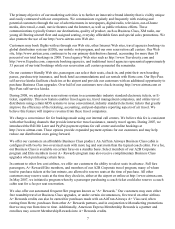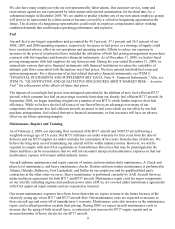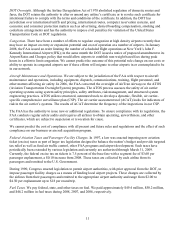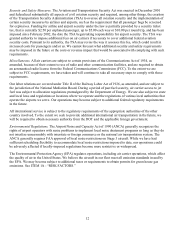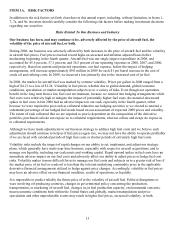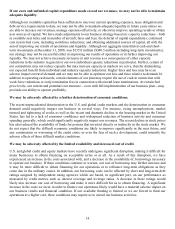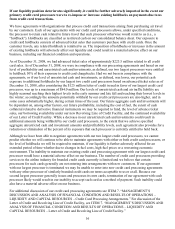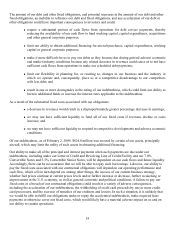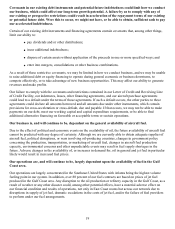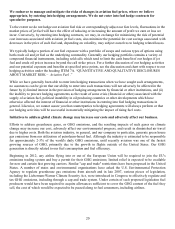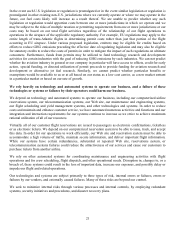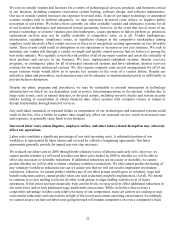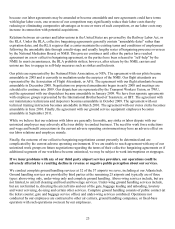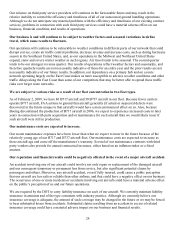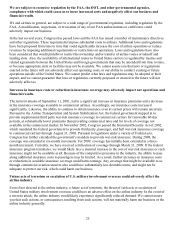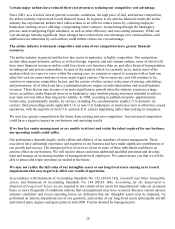Airtran 2008 Annual Report Download - page 25
Download and view the complete annual report
Please find page 25 of the 2008 Airtran annual report below. You can navigate through the pages in the report by either clicking on the pages listed below, or by using the keyword search tool below to find specific information within the annual report.Our results of operations, cash flows, and financial position are, and will continue to be, influenced by
economic conditions as demand for discretionary travel diminishes during economic downturns.
The airline industry is highly cyclical, and the growth in demand for air travel is correlated to the growth in the
U.S. and global economies. The profitability of our operations is especially influenced by the condition of the
United States economy, which may impact the demand for discretionary travel and our competitive pricing
position. Most air travel is price sensitive and discretionary travel, which is a substantial portion of our business,
declines during economic downturns. Our 2008 results of operations, cash flows, and financial condition were,
and our 2009 results of operation, cash flows, and financial condition likely will be, adversely affected by
recent, current, and emerging weak macroeconomic conditions in the United States, including the current
recession. A prolonged economic recession could have a significant adverse effect on our results of operations,
cash flows, and financial condition. Air travel tends to be seasonal. Demand tends to be highest in the second
quarter due to higher family air travel. Accordingly, the second quarter tends to be our strongest revenue
quarter. In light of economic conditions and rapidly changing network operations and travel pricing in our
industry, we cannot predicate whether demand for air travel either for the industry in general, or AirTran
Airways in particular, for 2009 will be in accord with recent historical seasonally adjusted demand.
Airline bankruptcies, strategic combinations, or industry consolidations could have an impact on our
competitive environment in ways yet to be determined.
The environment in the airline industry changes from time to time as carriers enter and, more rarely, exit the
U.S. market, implement varying strategies in pursuit of profitability, including consolidation to expand
operations and increase market strength and enter into national or global alliance arrangements. The bankruptcy,
merger or acquisition of one or more of our competitors may result in rapid changes to the identity of our
competitors in particular markets, a substantial reduction in the operating costs of our competitors or the entry
of new competitors into some or all of the markets we serve or currently are seeking to serve. We are unable to
predict exactly what effect, if any, changes in the strategic landscape might have on our business, financial
condition, and results of operations.
We have a significant amount of aircraft related fixed obligations that could impair our ability to make
principal and interest payments on our debt obligations and lease payments on our lease obligations.
We have significant obligations including debt and lease obligations related to aircraft purchase commitments,
aircraft delivery obligations and aircraft leases, debt and lease obligations for operating facilities, including
existing facilities and planned new facilities, and other cash obligations, which may include future funding
obligations for potential acquisitions. Our total indebtedness as of February 2, 2009 and December 31, 2008,
respectively, was approximately $1.0 billion and $1.1 billion, of which $824.8 million and $832.8 million,
respectively, was aircraft related. Our debt service obligations with respect to our indebtedness could have an
adverse impact on our earnings, cash flows, and financial position for as long as the indebtedness is outstanding.
Our ability to make scheduled payments of principal and interest for our financing obligations depends on our
future performance and financial results. These results are subject to general economic, financial, competitive,
legislative, regulatory and other factors that are, to some extent, beyond our control.
17


